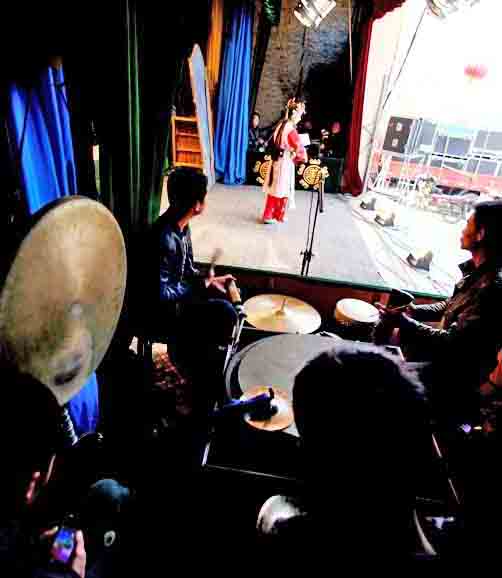‘18 folk dramas’ research yields insight into opera

Musicians play percussion instruments during a folk opera performance.
The “18 folk dramas” (Jianghu Shiba Ben) are classified as intangible cultural heritage and this collection is considered an example of traditional opera at the folk level.
To put it simply, “18 folk dramas” is a general term used by a theatrical folk troupe to refer to its repertoire of representative operas and does not refer to 18 specific performances.
It refers to operas that were repeatedly put on and best received by audiences during the troupe’s long-term itinerant performances.
In the Chinese language, particularly in ancient times, the number “18” (shiba) often indicates “large in quantity.” For example the adage “nüda shibabian” literally means “every girl changes 18 times before she grows up” and indicates a girl changes many times before becoming a woman. Another example, “shibaban wuyi” literally means “18 weapons and skills” and indicates that there are many skills and weapons that a kungfu martial artist must master.
This phrase has been used for a long period of history, during which there have been significant changes in the material and spiritual lives of folks in different periods. Operas included in this list vary in different regions, historical periods and for different troupes. And even the same opera can vary in styles with changes of location and times. Nonetheless, every opera contained in this category is rich in cultural nuances.
Studies of the 18 folk dramas can reveal the way a folk theatrical opera troupe survives, the preferences of opera audiences, regional differences of opera performances, how different operas influence each other, how the legacies of operas are passed down, and other issues pertaining to operas.
However, because the so-called 18 folk dramas are only popular at the folk level, and lack official recognition, records of them throughout history are rare and even contemporary scholars have overlooked them.
Records of this phenomenon mostly originated in the reign of Emperor Qianlong (1711-1799) during the Qing Dynasty (1616-1911). It is mentioned in one of the works of Qing poet and dramatist Jiang Shiquan that marionette troupes at that time used the term “18 folk dramas” to boast about performances and popularity. Therefore, this saying emerged before 1751, the sixteenth year of Qianlong’s reign, when the work was completed.
Among all the sets of 18 folk dramas handed down, those of the Gaoqiang Opera (or “high pitched music”) were best preserved, which can be attributed to the religious and ethnic elements associated with this artistic form. After the 18 folk dramas of the Raohe Opera, a type of Gaoqiang Opera, became well-known in the northeast of Jiangxi Province, many other types of operas formed their own 18 folk dramas, such as Zhejiang Wu Opera, Sichuan Opera, Henan Opera, Cantonese Opera, Hebei Bangzi Opera, and Peking Opera.
To use modern parlance, the term “18 folk dramas” represents a kind of brand. But they are not devoid of content. They have distinctive features associated with their original cultures in different regions and periods. For example, Jiangxi Gan Opera was more about heroic romances, Zhejiang Wu Opera generally pertained to belief in Guanyin, a Bodhisattva, and Sichuan Opera largely contained stories of genius and beauty.
The formation and maintenance of the 18 folk dramas were conducive to transmitting these operas, right up until the present day. They were co-created by artists as well as audiences, one generation after another. They carry with them the emotional worlds of ordinary people in different periods. Opera artists made adaptations to these operas in order to cater to changing audiences and conform to different contexts in which these operas were performed. In this way these operas managed to retain their strong vitality.
Bai Haiying is from South China Agricultural University.
